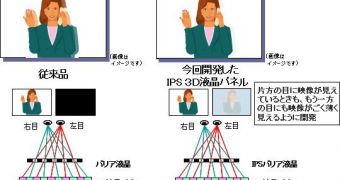Not too long ago, Nintendo announced that it would be making a small handheld gaming device equipped with a feature that the display industry had been seeking for many a month. To be precise, the Nintendo 3DS is going to boast a 3.4-inch display, developed by Sharp, that will relay 3D images without the need for special glasses.
One would expect 3D gaming to first take off in the PC market, where the size of displays and the graphics capabilities evolve fast enough and are already sufficiently powerful to handle even large format applications. Still, Nintendo seems to have special plans for this type of display option, which is why it so suddenly made the 3DS announcement. More recently, however, it seems that Sharp might be getting competition quite early on, from Hitachi, to be exact.
Hitachi has just unveiled a 3.1-inch parallax barrier 3D IPS LCD display that, like the offer from Sharp, does not need end-users to wear special glasses. Basically, glasses-less (so to speak) 3D relies on the screen's ability to send the two sets of images (left and right) directly to each eye. This is accomplished thanks to a series of vertical slits in the IPS liquid crystal display (LCD) that directs light accordingly. Other specifications of the small panel include a size of 38.16 x 67.893 mm, a brightness of 400cd / m² (lower than Sharp's 500nits) and a maximum resolution of 480 x 854. Furthermore, the screen has a contrast ratio of 1,000:1 and a color reproducibility of 70%.
At first glance, consumers may wonder why Hitachi has made this move now, when there are no Nintendo 3DS competitors. Those that are familiar with the Nintendo, Sharp, Hitachi trio, however, might know that the last two have both had a long relationship with the game developer. As such, when Nintendo finally introduces the 3DS, either of the two, or even both, may have the position of partner. Regardless of the outcome, this 3D screen is still a step forward towards glasses-free 3D.
It is unknown when, if ever, the company will make any such displays using a larger form factor.

 14 DAY TRIAL //
14 DAY TRIAL //